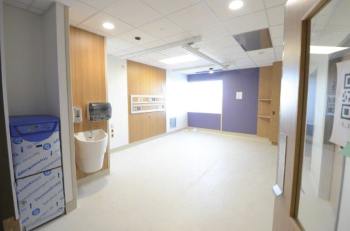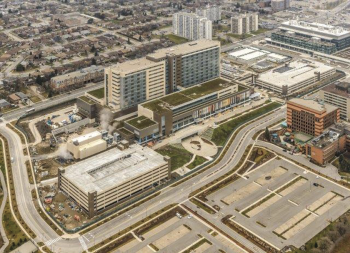
New hospital means healthier community and cleaner environment
By Carla Peacock.
At Humber River Hospital, we believe health, health care and the environment are inextricably linked. That’s exactly why the new Humber River Hospital (HRH) has been built with ‘green’ design principles that help create healthy indoor and outdoor environments, reduce greenhouse gas emissions and promote the efficient use of energy and water.
The 30-acre campus is designed to promote healthy lifestyles for patients and our community through increased physical activity in appealing, secure and comfortable walking areas and gardens. Everyone is also welcome to enjoy the terraced lawns and community amphitheatre.
But the campus isn’t the only area with landscaping; there are ten distinct sections of green roofs. Comprising 50% of the total roof area, these areas feature a variety of highly drought tolerant plants. These plants help manage the rain run-off by using it and returning a portion of it to the atmosphere through evaporation.
The run-off that isn’t absorbed by the green roofs will be captured in two 50,000 litre cisterns and used for landscape irrigation. Conserving water and reusing it in natural environments supports environmental sustainability.

White roofs make up the remaining 50% of the roof area. These reflect sunlight, helping reduce heat gain and lowering the amount of energy used to control the building temperature. Combine this with the insulation benefits of the green roofs and HRH is significantly reducing energy use all year long. Green and white roofs also help keep the atmosphere around the building cooler than if a conventional roof was used. This reduces the ‘heat island affect’ that often occurs in urban settings, where the high concentration of concrete and black roofs raise local temperatures.
Commitment to a sustainable health care facility has direct benefits for patients as well. Reuben Devlin, President & CEO of Humber River Hospital, says “we need to understand that environmental sustainability means a better quality of life for patients, for staff and physicians, for everybody. I’m in the people care business; every dollar I save on energy resources, I put into providing patient care.”
You can imagine how much lighting is needed in a 1.8 million square foot hospital that is open 24 hours a day, seven days a week. Obviously not all lights need to be on all the time, so in the new Humber River Hospital motion-sensitive lights are used to light your path, and turn off automatically after a certain amount of time with no movement detected. This automated system along with extensive use of LED lighting contributes to improved efficiency and reduced energy use. 
Natural lighting is maximized wherever possible in the new hospital, including large windows in all inpatient rooms. But these aren’t just your average windows. In unoccupied patient rooms, they tint throughout the day using global positioning and time of year programming to provide shade and privacy. This is called “VIEW Dynamic Glass” with technology that controls the amount of sunlight that gets through the windows, allowing for anything between complete transparency and complete darkness – all without curtains. If the room is occupied, the patient can control the amount of tint in the VIEW glass from their bedside computer terminal.
Energy efficiency is indeed an integral feature of the new hospital. Lorie Pella, Director of Projects & Planning says “our goal was to ensure the design and construction achieves Leadership in Energy and Environmental Design (LEED) Silver certification, however, we are on track to achieving LEED Gold status.” By achieving LEED design and other green standards from organizations such as the American Society of Heating, Refrigerating, and Air-Conditioning Engineers (ASHRAE), the new HRH building will be the most energy efficient hospital of its size in North America.
The benefits of an environmentally-sensitive hospital for patients, staff, physicians and our community are great. Compared to the three current Humber River Hospital campuses, the new facility set to open October 18, 2015, will cut energy consumption by over 40%. This means that the facility will cost less to operate, use less energy, and can improve comfort levels for patients and staff. With lower operational costs, Humber River Hospital can direct more dollars to front line services, providing enhanced, quality health care.
When you use less energy, greenhouse gas emissions (CO2) are also reduced. In fact, the new Humber River Hospital will reduce CO2 by roughly 20,000 tons a year, the equivalent to taking about 4,000 vehicles off the road. This leads to improved air quality, a healthier community, and a cleaner environment. Every little bit contributes to the health of our patients and community today, and for generations to come.



















